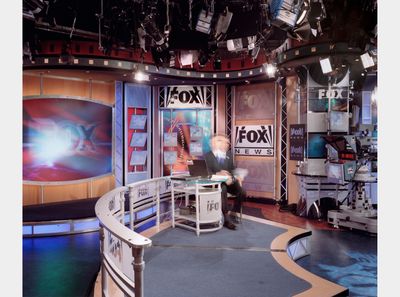Can an Artwork Ever Be Grounds for Defamation?
Does an unflattering portrayal ever warrant legal action? Aimee Gavin, a solicitor at London law firm Howard Kennedy LLP, weighs in.

Sean Hemmerle, Fox News, New York (2005–2015). Digital chromogenic print. 62 x 74 cm. From the project 'Media Nodes'. Courtesy Galerie Julian Sander.
Last month, Fox News agreed to pay a whopping US $787.5 million to settle a defamation claim brought against them by Dominion Voting Systems. Defamation claims are not unusual in politics or the media, but do such claims ever occur in the art world? Could an artwork ever be grounds for defamation?
Artworks can, in theory, convey a defamatory meaning. The principle was tried almost a century ago in the English case of Tolley v Fry (1931) where it was held that a caricature could be libellous.
The likeness in question was that of a prominent amateur golfer, Mr Tolley. Mr Tolley was painted on the golf course with a bar of the defendant's chocolate protruding from his pocket. The implication was, the claimant argued, that he had consented to the use of his image to reap financial gain.
At trial, golfers attested that such an advertisement could result in a golfer losing their amateur status and being dismissed from their club. The House of Lords found that the depiction held the meaning put forward by the claimant, with the judgment making clear that the defamatory innuendo depended 'solely upon the circumstances in which the publication takes place'. In other words, the fact that Mr Tolley was an amateur golfer was materially important to the finding of a defamatory meaning.
In another incidence of alleged libellous advertising, Hustler Magazine Inc v Falwell (1988), a spoof advertisement depicted a then prominent televangelist as having had an incestuous encounter. The advertisement parodied the aesthetic and tagline of a popular Campari Liqueur ad series and included a small footnote disclaiming 'ad parody—not to be taken seriously'. Perhaps unsurprisingly, the U.S. court did not consider that the advertisement would reasonably be understood as factual and ruled against the claimant with regards to libel.
Notwithstanding the legal precedent set by Tolley, the principle of art holding a defamatory meaning has yet to be confirmed in the English courts.
Cartoons, whose appeal often derives from the satirical depiction of real-life persons, rarely solicit defamation claims for the same reasons as satirical advertisements. There are very few libel claims conceived from this form of parody due to the difficulty of demonstrating that the meaning would reasonably be interpreted as true, even when read in conjunction with a salacious caption.
Even art critics, who historically have not held back in delivering scathing reviews, are infrequently defendants in libel actions despite being live to the risks of defamation.
Depending on the statement in question, it is likely that a critic facing a defamation claim would have a defence of honest opinion, if the claim were brought in a jurisdiction where such a defence is available.
A number of art terms we no longer find pejorative began as insults. 'Baroque' originally meant 'irregular' or 'bizarre', 'Fauvism' comes from the French for 'wild beasts', and 'The Impressionists' is a term coined by French art critic Louis Leroy to satirise works by Claude Monet, Berthe Morisot, and others.
To this day, there has been no shortage of derisory reviews targeting contemporary art, especially in relation to its use of unconventional mediums, materials, and subject matter.
Despite the potential for both art criticism and visual representations to hold defamatory meanings, claimants may be reluctant to pursue a defamation action where there are so few legal precedents. The costs of litigation and the publicity such a claim would bring within the art world act as strong deterrents to bringing proceedings. —[O]







































































































































































